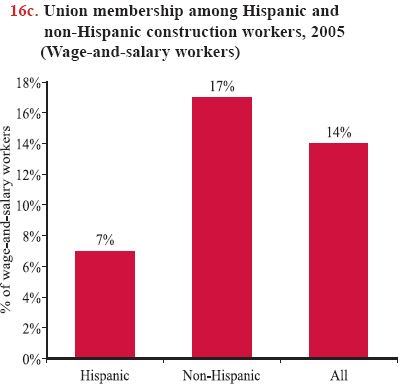Summary Statement
A broad collection of tables and charts covering health and safety in the U.S. construction industry, as well as considerable economic and training data.
2007
Section 16: Hispanic Workers in Construction Occupations
Hispanic workers have played a large role in the growth of construction employment, particularly in production, or blue collar, occupations (see chart book page 10). From 2000 to 2005, three out of four new construction jobs in production occupations were filled by Hispanic workers.1 But the distribution of Hispanic construction workers differs from non-Hispanic workers, as Hispanic workers are less likely to be managers and more likely to work in production. In 2005, 2.4 million Hispanics made up 27.5% of the workforce in blue-collar construction jobs, yet they held a 23% share of all types of construction employment (see chart book page 15).
Hispanic workers are more likely to work in lowerskilled occupations. Overall in 2005, more than 92% of Hispanic construction workers were employed in production occupations, compared with 73% of non-Hispanic workers. For instance, of the 2.6 million construction workers of Hispanic origin in 2005, 23% were laborers and helpers: 14% of all construction workers were in this occupation (chart 16a). When Hispanic construction workers are considered as a percentage of each occupation, 49% of drywall workers are Hispanic (chart 16b).Hispanic workers in lower-skilled occupations are more likely to be new immigrants. More than one-third (34%) of construction laborers who identified themselves as of Hispanic origin entered the United States after 2000, while the proportion was 28.5% for overall Hispanic construction workers (see chart book page 14). Also, many foreign-born construction workers are not proficient in English. Among the Hispanic production workers who speak languages other than English at home (see chart book page 14), 42% reported they cannot speak English very well, and the same proportion (42%) reported they cannot speak English at all.
Hispanic construction workers are less likely to be union members than non-Hispanic construction workers (chart 16c). In 2005, less than 14% of union members in construction were of Hispanic origin although Hispanic workers accounted for 23% of the construction workforce that year. The lower union membership among Hispanic workers has a negative effect on their wages, health insurance, pension, and other benefits (see chart book pages 23, 26, and 27).
As with construction workers overall, most Hispanic construction workers are male. But among females, the breakdown for Hispanics is atypical. Less than 5% of all Hispanic construction workers are female, including administrative support (clerical), compared with 10% female workers in the entire construction workforce (see chart book page 18).
Compared with non-Hispanic construction workers, on average, Hispanic construction workers are younger (see chart book page 13) and less educated (see chart book page 28), receive lower wages (see chart book page 23), and are more likely to be injured at worksites (see chart book page 34).
People of Hispanic origin may be white, black, American Indian, Aleut, Eskimo, Asian, or Pacific Islander; thus, the numbers overlap with data showing construction employees who are members of racial minorities (see chart book page 17).



Download MS PowerPoint versions of Charts
1. Hispanic employment in production occupations increased by 1.06 million from 2000 to 2005, while overall construction production employment increased by 1.41 million during that time period. Calculations by CPWR Data Center.
Note:
All charts - Total of 2.6 million Hispanic construction workers (all types of employment) in 2005.
Charts 16a and 16b - Data are averaged over three years to get statistically valid numbers.
Source:
Charts 16a and 16b - U.S. Bureau of Labor Statistics, 2003, 2004, and 2005 Current Population Survey. Calculations by CPWR Data Center.
Chart 16c - U.S. Bureau of Labor Statistics, 2005 Current Population Survey. Calculations by CPWR Data Center.
Back to Table of Contents


